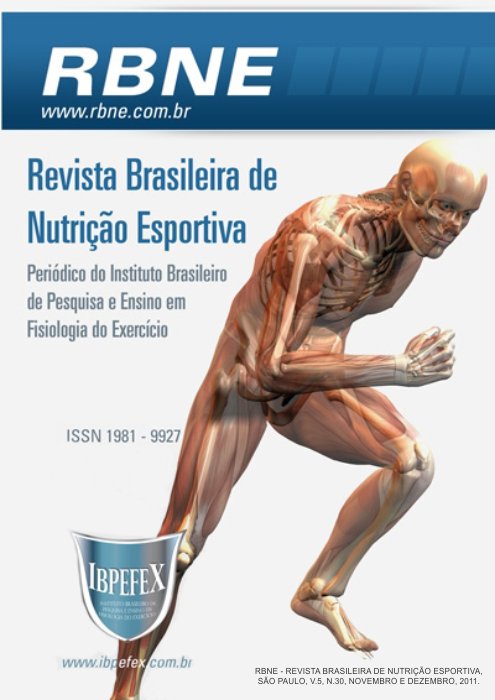Energy expenditure during a race orienteering
Abstract
The objective of this Study was to estimate the energy expenditure during a race pedestrian orienteering in male athletes of category H21E. The study population was consisted of runners affiliated to the Gaúcha Orienteering Federation (FGO) and the Brazilian Orienteering Confederation (CBO). The sample consisted of 06 athletes from the elite category. They followed a track with 30 control points, with a distance between the points a total of 8100 meters. Therefore, to determine the distance and time, were used the Helga Orienteering Software Program, version 2010/07-1, specific software for analysis of route guidance. Through the OCAD Program was made a topographical analysis of the letter and thus determining the slope the terrain. The O2 consumption is a function that depends on the intensity of the work performed and body mass displaced, so it was necessary to check the corporal weight of each athlete. To represent the amount of energy expended was used the formula where 1 = V02 1 .min 5 Kcal. To estimate O2 consumption equations were used to ACSM, during the race at speeds above 134 m / min, we used the formula, VO2 = (0.2 x speed) + (0,9 x speed x 9 x Tilt) + 3.5 and for walking at speeds between 50 and 100 m / min the equation, VO2 = (speed x 0.1) (1.8 x speed x Tilt) + 3.5 and for speed between 100m/min and 134m/min, considered trot, it was for this work the same formula of the race, this equation is capable of use for these speeds if the individual is actually running. The average energy consumption of advisors during the execution of the track was 659.43 kcal. It is concluded that physical activity performed was predominantly aerobic, intensity medium, but the supervisor needs to constantly anaerobic substrate, due to constant changes of pace and intensity.
References
-AmericanCollege of Sports Medicine.Manual do ACSM para teste de esforço e prescrição de exercício. 5ª edição. Revinter. Rio de Janeiro.2000.
-Aoki,M. S. Fisiologia, treinamento e nutrição aplicados ao futebol. Jundiaí.Fontoura.2002.
-Bird, S.; Balmer, J.; Olds, T.; Davison, R. C. Differences between the sexes and age-related changes in orienteering speed. J Sports Sci. 2001.
-CBO. Regras do desporto Orientação da Confederação Brasileira de Orientação. Santa Maria. CBO.2000. Disponível em: http://www.cbo.org.br/site/regras/index.php. Acessado em 12/04/2010.
-Diener,J. R. C. Calorimetria Indireta. Rev. Ass. Med Brasil. Vol. 3. Núm. 43. p. 245-253. 1997.
-Ferreira, A. A. M. Perfil dermatoglífico, somatotípico e das qualidades de atletas brasileiros de corrida de orientação de alto rendimento. Dissertação de Mestrado. Universidade Castelo Branco. Rio de Janeiro. 2003.
-Ghorayeb, N.; Barros, T.L. Exercício. Preparação Fisiológica, Avaliação Médica: Aspectos Especiais Preventivos. São Paulo. Editora Atheneu1999.
-Liberali, R. Metodologia Científica Prática: um saber-fazer competente da saúde à educação. Florianópolis.2008.
-Marins, J. C. Avaliação e prescrição de atividade física: guia prático. 2ª edição. Shape.1998.
-Passini, C.G.D. Disciplina de orientação e o currículo de educação física do ensino superior. Uma inclusão necessária. Dissertação de Mestrado. Universidade Vale do Rio Verde.2003.
-Pollock, M. L.; Wilmore, J. H. Exercícios na saúde e na doença: avaliação e prescrição para reabilitação. 2ªedição. Rio de Janeiro. MEDSI.1993.
-Silva, A. I.; Añes, C. R. R. Dispêndio energético do árbitro e do árbitro assistente de futebol. Revista da Educação Física/UEM. Vol. 12. Núm. 2. p. 113-118. 2001.
-Smekal, G.; VonDuvillard, S. P.; Pokan, R.; Lang, K.; Baron, R.; Tschan, H.; Hofmann, P.; Bachl, N. Respiratory gas exchange and lactate measures during competitive orienteering. Medicine and Science in sports and exercise. Vol. 35. Issue 4. p. 682-689. 2003.
-Tirapegui, J. Nutrição: fundamentos e aspectos atuais. 2a edição. São Paulo; Atheneu, 2006.
-Zurcher, S.; Clénin, G.; Marti, B. Uphill running capacity in Swiss elite orienteers. Scientific Journal of Orienteering. Vol. 16. p. 04-11. 2005.
Authors who publish in this journal agree to the following terms:
- Authors retain the copyright and grant the journal the right of first publication, with work simultaneously licensed under the Creative Commons Attribution License BY-NC which allows the sharing of the work with acknowledgment of the authorship of the work and initial publication in this journal.
- Authors are authorized to enter into additional contracts separately for non-exclusive distribution of the version of the work published in this journal (eg, publishing in institutional repository or book chapter), with acknowledgment of authorship and initial publication in this journal.
- Authors are allowed and encouraged to post and distribute their work online (eg, in institutional repositories or on their personal page) at any point before or during the editorial process, as this can bring about productive change as well as increase impact and impact. citation of published work (See The Effect of Free Access).






